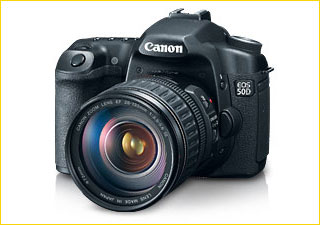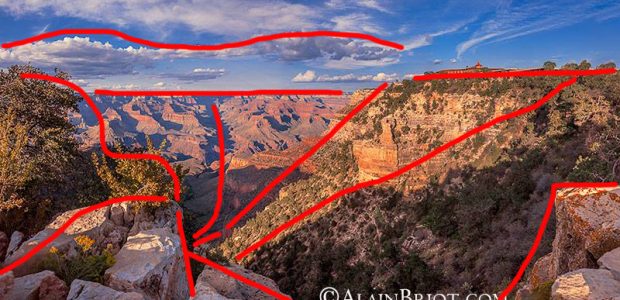
The recently introduced Canon 50D is a milestone camera: a camera that marks a new level of technical achievement in some way. Before I explain how, let me provide some background.
About a dozen years ago – I really can’t remember exactly when it was – I was asked how many pixels would we need to equal what can be done with a traditional 35 mm camera. My answer was based on the best I could do at the time with slow black and white film: about 200 dots (pixels) per millimeter. For a 24 by 36 millimeter frame, that corresponds to about 35 megapixels. After consulting some Kodak information on colour film resolution, my estimate for a colour images was 9 megapixels.
When I commented (on Luminous Landscape) some years ago about the Canon D60 camera I indicated that the 6 megapixels of the D60 provided an image that was almost the equal of 35 mm colour film in some respects and yet characteristic of medium format results in others, especially grain-free smooth tonal transitions. In retrospect, I would have to say that at 8 megapixels the Canon 20D was better than 35mm colour film in almost all respects and was invading, if not exactly threatening, the 645 format capabilities. When I arrived at that 9 megapixel number years ago I had not taken into account is how digital cameras retain better contrast than film for fine detail. But then as the detail becomes finer still, the digital camera – unlike film – suddenly washes out completely. Today I accept that even for black and white images, digital cameras do a better job than I had anticipated.
Back to the Canon 50D. The first thing I did with a 50D was to put the nearest lens at hand – a Canon 50/1.2L – on the camera, step outside my front door and take a picture of the house across the street. Then I looked at the image on the computer. "Finally!" my eyes told me "I can see the sort of detail I used to see with slow, fine-grain, b&w film!" What particularly grabbed my attention was that I could tell the maple trees behind the house from the oak trees, by the shape of the leaves. That’s the sort of thing I used to see with b&w images from a Leica M6.
Then I remembered that the 50D is roughly an APS-format camera, and consequently I was not going to see all the detail I expected in a full frame Leica b&w image. Still, I was moved to make a quantitative comparison. Consulting the 50D specifications, I noted that the 50D sensor has 213 pixels per millimeter! On a full frame sensor that would be almost 39 megapixels – better than virtually any film, b&w or colour. So my initial assessment did have some merit!
My next step was to take a number of ‘real’ pictures. These were taken with a 24-105/4L zoom lens that up until now has seemed just about perfect, except for some correctable red fringing at the wide end of the zoom range. The 50D pictures were not what I expected. Overall, the level of detail was lower than I anticipated. Second, the corners looked somewhat smeared. And third, I couldn’t correct the red fringing in Photoshop without destroying the overall sharpness of the image, even in the center. This led to a few new conclusions. First, I was dealing with only 15 megapixels, not 39. Second, for some reason as yet unexplained, for many of the shots, the autofocus system was not focusing accurately enough. Third, I was using an aperture (f/11) that was too small. And fourth, yes, uncorrectable lens aberrations were showing up with the 24-105. I tried substituting a 16-35/2.8L II and that seemed to clear things up; there was still some pink or red fringing, but Photoshop could take care of it.
.jpg../../images-86/Fig1(FishCove).jpg)
Fig 1
Let’s look at one of the examples. This (Fig1) is a shot of one of my favourite places to check things out: Fisherman’s Cove in Eastern Passage (part of Halifax Harbour). The lens used was the 24-105. This image has been corrected as much as possible using Photoshop’s lens correction tools (using Camera Raw), without destroying the overall sharpness. Residual red fringing was still quite evident, but fortunately it was always against a neutral tone background and could thus be removed through appropriate selection and then saturation reduction and density adjustment. (Yes, I had specified "desaturate all edges".) I printed the image at 14 by 21 inches. It looks pretty good: better than I could have done with 35 mm colour film. But the corners do show some image smearing. I have reproduced the lower right-hand corner pixel-for-pixel for the original image (Fig2), for the image corrected as much as possible for colour fringing (Fig3) and for a third example I’ll describe next.


Fig 2
Fig 3
I had never noticed uncorrectable colour fringing with a 40D. Can this really be? Can just a change from 10 megapixels to 15 megapixels make that much difference? If I’d been asked the question in advance, I’d have said "no". But I did another experiment. I took the original (unedited) 15 megapixel image, down-sampled it in Photoshop to 10.1 megapixels and then applied the lens correction. To my surprise, it worked (Fig4)! I was indeed able to eliminate all but an almost unnoticeable amount of colour fringing without negatively affecting the overall sharpness of the image. The effect is real! The move from 10 megapixels to 15 megapixels really does make those nasty lens aberrations significantly more difficult to deal with. From now on, photographers working with cameras having the resolving potential of the 50D (or better) will need to choose lenses very carefully. And they will have to learn to focus carefully as well.

Fig 4
For those contemplating the purchase of a 5D II, you need not be so concerned. The pixel density that yields 10 megapixels in the 40D would yield about 26 megapixels full frame. So at 21 megapixels, the 5D II is actually more forgiving of lens defects than the 40D.
My contention is that the Canon 50D ushers in a new era where we will need distinctly better lenses and finer focusing skills than we have needed thus far with digital SLR cameras. In the days of film I always used a Leica rangefinder for 35 mm b&w, but a Canon SLR or Mamiya M645 for colour. In this modern digital era I no longer need to resort to medium format to achieve my desired standard in colour images, but I certainly will be wanting better SLR lenses. That photo of Fisherman’s Cove looks very good indeed if I regard it as just the central 40% of a 24 by 36 inch print. But I am worried about how the corners would look!
____________________________________________________________________________________
Other Comments
A natural concern with any new camera having a high pixel density is high ISO performance. I did try a few shots at ISO 3200 and was not impressed. The images improved in both overall appearance and apparent sharpness when I downsampled them to half their original resolution (yielding images of just 3.75 megapixels).
A much-touted feature of the camera is the new viewing screen on the back of the camera. Yes, it’s a nice screen: sharper, brighter and easier to view in poor conditions, but still less than optimal in bright sunshine, especially with a nose print or two on the screen.
The means of changing recorded file types has been changed from earlier Canon cameras. After selecting the ISO setting screen, the front "Main Dial" controller (near the shutter release) sets the JPEG size and quality while the rotary dial (Quick Control Dial) on the camera back controls the RAW selection. The first time I tried this I forgot to press the "SET" button and, as a result that Fisherman’s Cove photo used here got recorded only as a highest quality JPEG. But that was my fault. The new procedure is actually better than the previous method of cycling through all the possibilities. While on this subject I wish there were 10 megapixel size choices for both JPEG and sRAW. I doubt that I will very often choose to go with an 8 or 7 megapixel file, whereas I would use a 10 megapixel option.
LiveView? Well, it is not a big factor for me. I never even tried it with the 40D. The procedure for the 50D seems a bit more logical (than for the 40D) to me and I did actually play with it once. It will take a special situation to cause me to use it in earnest.
The 50D review at the Digital Camera Review site suggests that the "per pixel" resolution of this camera is not up to the standard of previous cameras. That’s not quite how I saw it, although I think in many ways we are observing the same effect. I saw quite good per-pixel images when I used the right lens at the right aperture and managed to focus it properly. There’s little question, however, that this camera marks new territory in the realm of imaging with a 35mm SLR style digital camera. The diffraction-limited resolution aperture for this sensor is around f/7! (The appropriate formula is: diffraction limited aperture equals 1600 divided by the pixel pitch in pixels per millimeter.) Using smaller apertures – say f/11 – will result in images with significant softness. The 50D is a great camera for testing lenses and focusing ability!
I look forward to the day when we have full-frame sensors with the resolution of the 50D. I don’t mind that it might be overkill for many applications. I’ll happily down-sample images to 10, 15 or 20 megapixels to hide lens aberrations or noise when necessary! I would expect most users, however, to find the 10 megapixels of the 40D quite sufficient for their purposes, and the extra care required with the 50D to be more of an annoyance than a benefit. It tends to make lens aberrations and errors of judgment (such as using too small an aperture) more obvious when viewing on screen at 100%, even if the final print is not much different.
December, 2008
____________________________________________________________________________________
Harold Merklingeris a highly regarded scientist and author. He retired in 2001 as Director-General of the Defence Research Establishment Atlantic in Dartmouth Nova Scotia, doing sonar research for the Canadian Navy and Air Force. He has written two short technical books on photography and numerous articles for Shutterbug, View Camera, and Photo Techniques. He is a regular contributor to The Luminous Landscape..
You May Also Enjoy...
How This Photograph Was Made: Grand Canyon Daytime Part 2: Let’s talk about composition
Good composition is like a suspension bridge - each line adds strength and takes none away. Robert Henri 1 - Introduction This is part two
What’s New ’99
This page contains descriptions of changes made to this site during 1999.Current site update information is foundhere.Please check theTable of Contentsfor a complete overview of

